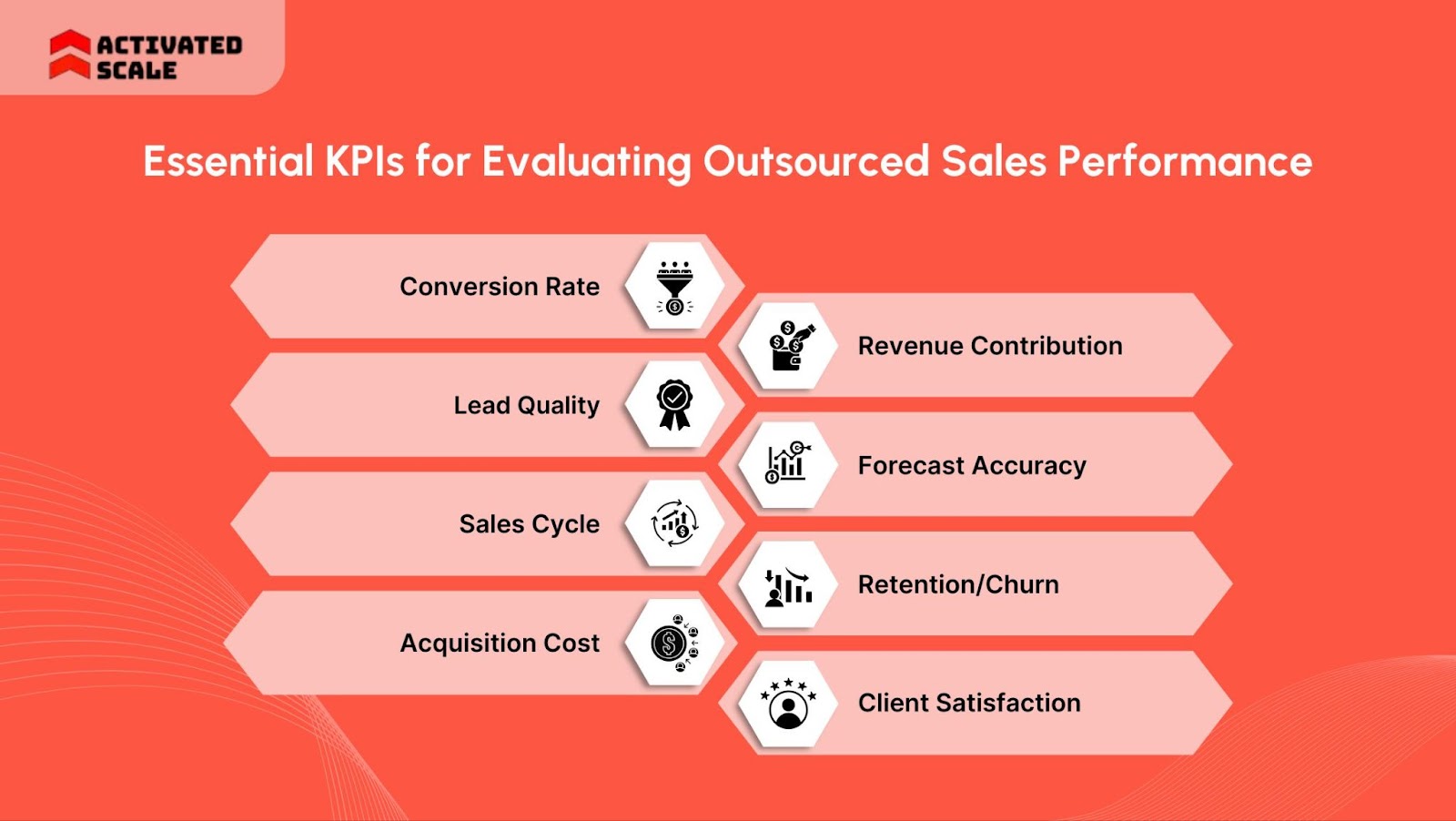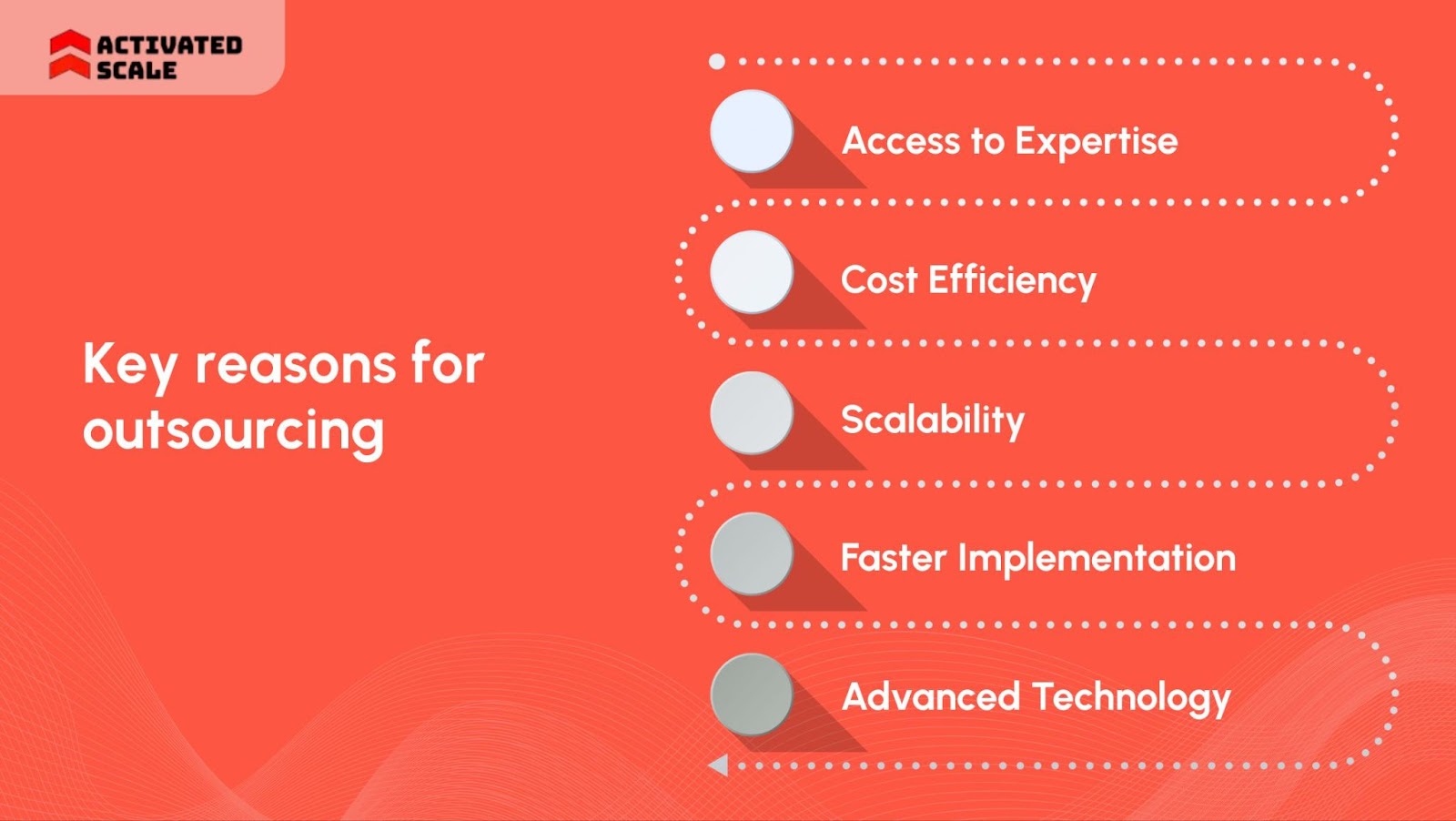Outsourcing sales teams can be a strategic way to scale your business, but how do you know if it’s working? That’s where sales team performance analytics come in. In fact, companies using performance analytics are 2.5 times more likely to exceed their sales goals.
By tracking the right metrics, you can gain deeper insights into how your outsourced team is performing, pinpoint areas for improvement, and maximize ROI.
It’s a fact that organizations using data-driven sales performance analytics are more productive and profitable than competitors relying on instinct alone.
If you’re just starting with sales outsourcing or aiming to take your existing strategy to the next level, the right data can set you apart.
Let’s turn your outsourced sales team into a performance powerhouse.
Key Summary (TL;DR)
- Optimize Outsourced Sales: Data-driven insights can boost the efficiency and revenue of outsourced sales teams.
- Essential KPIs: Track metrics like conversion rate, sales cycle, CAC, and client satisfaction to measure performance.
- Tackle Challenges: Address data security, integration, and KPI alignment with clear communication and reliable tools.
- Actionable Insights: Focus on insights that are both reliable and directly actionable to improve sales strategies.
8 Essential KPIs for Evaluating Outsourced Sales Performance

When it comes to evaluating the performance of outsourced sales teams, using the right Key Performance Indicators (KPIs) is essential.
KPIs not only provide measurable outcomes but also help businesses understand how well outsourced teams are driving value and contributing to organizational goals.
Below are eight critical KPIs that can help businesses effectively measure and optimize outsourced sales performance:
1. Conversion Rate
= (Number of Sales ÷ Number of Leads) × 100
- What It Measures: The conversion rate tracks the percentage of leads that are successfully converted into customers. This is a direct measure of how effective the sales team is at turning prospects into paying customers.
- Why It’s Important: A high conversion rate indicates that your outsourced team is skilled at moving leads through the sales funnel. It helps businesses gauge the effectiveness of sales strategies, pitch quality, and customer engagement tactics.
- Pro Tip: To get the most out of this KPI, segment your conversion rates by lead source or sales strategy to identify the most effective channels or approaches.
2. Lead Quality & Response Time
Response Time = Time of First Contact − Time Lead is Generated
Lead Quality = (Qualified Leads ÷ Total Leads) × 100
- What It Measures: This KPI measures both the quality of leads generated and the speed at which the outsourced team responds to these leads.
- Why It’s Important: Lead quality is crucial for ensuring that the sales team is focusing on the right prospects. Quick responses to high-quality leads help close deals faster and demonstrate strong customer service.
- Pro Tip: Combine this KPI with lead scoring, which helps prioritize leads based on their likelihood to convert, ensuring that your outsourced team focuses on high-value opportunities.
3. Sales Cycle Length
= Total Time to Close All Deals ÷ Number of Deals Closed
- What It Measures: This measures the average time it takes for a lead to move through the entire sales process, from first contact to closed deal.
- Why It’s Important: A shorter sales cycle typically indicates that your outsourced team is efficient, engaging customers effectively, and closing deals quickly. A longer sales cycle may indicate inefficiencies or roadblocks in the sales process.
- Pro Tip: Track this KPI across different sales reps or sales strategies to identify areas where the sales cycle could be shortened, such as lead qualification or follow-up processes.
4. Customer Acquisition Cost (CAC)
= Sales & Marketing Costs ÷ Number of New Customers Acquired
- What It Measures: CAC calculates the total cost spent on acquiring new customers, including marketing, sales team salaries, and other operational costs.
- Why It’s Important: This KPI is critical for understanding the financial efficiency of your outsourced sales efforts. A low CAC indicates that your team is acquiring customers at an affordable cost, while a high CAC could signal the need for optimization.
- Pro Tip: Track CAC for each customer segment or sales campaign to identify where you are getting the most cost-effective conversions.
5. Revenue Contribution & Attribution
= (Revenue from Outsourced Sales ÷ Total Revenue) × 100
- What It Measures: This measures the direct contribution of the outsourced sales team to overall revenue and ensures that revenue can be attributed to the correct source (i.e., the outsourced team’s efforts).
- Why It’s Important: Tracking this KPI allows you to assess the direct impact your outsourced sales team is having on your bottom line. It helps ensure that the value added by the outsourced team is properly recognized and rewarded.
- Pro Tip: Use a multi-touch attribution model to capture all the interactions a customer has with the sales team across various touchpoints, allowing for more accurate revenue attribution.
6. Forecast Accuracy
= (Forecasted Sales − Actual Sales) ÷ Forecasted Sales × 100
- What It Measures: This KPI tracks how accurate the outsourced sales team’s sales forecasts are compared to actual sales numbers.
- Why It’s Important: Accurate sales forecasting is critical for budgeting, resource allocation, and strategic planning. A reliable outsourced team will provide forecasts that closely align with actual sales, reducing uncertainty and helping with long-term planning.
- Pro Tip: Break this KPI down by rep, team, or region to identify where forecasting discrepancies may exist and fine-tune your approach.
7. Customer Retention/Churn
= Retention Rate = ((E − N) ÷ S) × 100
Where: E = Customers at End, N = New Customers, S = Customers at Start
- What It Measures: This KPI measures the rate at which customers remain loyal to your business versus the rate at which they leave (churn).
- Why It’s Important: Customer retention is crucial for sustaining long-term revenue growth. A high churn rate can indicate issues with the outsourced team’s relationship management or product fit, while a high retention rate suggests strong customer satisfaction.
- Pro Tip: Segment your customer retention by customer type or sales rep to see if particular groups are more likely to stay or leave.
8. Client Satisfaction & Feedback
= Use CSAT (Customer Satisfaction Score) = (Sum of Scores ÷ Total Responses) × 100 or NPS
- What It Measures: This KPI gauges how satisfied customers are with the sales process, the product, and the overall experience.
- Why It’s Important: High client satisfaction is often linked to increased loyalty, repeat business, and positive referrals. This is a direct indicator of how well the outsourced sales team is managing customer relationships.
- Pro Tip: Regularly survey customers post-purchase to gather feedback and measure satisfaction across different touchpoints (sales interactions, post-sale support, etc.)
How to Select the Right KPIs for Your Outsourcing Model
Choosing the right KPIs depends on your business goals, industry, and the specific objectives you want to achieve with your outsourced sales team. Here are some guidelines for selecting the best KPIs:
- Align KPIs with Business Objectives: Ensure that the KPIs you select are directly tied to your overall business goals. For instance, if you're aiming to grow revenue, prioritize KPIs like conversion rate, revenue contribution, and sales cycle length.
- Tailor to the Sales Model: Different sales models (B2B vs. B2C, inbound vs. outbound) will require different KPIs. For B2B, focus on lead quality and sales cycle length, while for B2C, client satisfaction and retention might be more important.
- Consider Vendor-Specific Metrics: For outsourced teams, consider including KPIs that assess vendor performance, such as vendor consistency, engagement levels, and communication effectiveness. These metrics help ensure that your outsourced sales team is working in sync with your business needs.
- Focus on Actionable Metrics: Select KPIs that provide clear insights and can lead to actionable improvements. Metrics like CAC or forecast accuracy can reveal areas that require immediate attention, whereas more granular data like lead response time may be better suited for process improvements.
Also Read: Understanding the Differences and Definition of Inbound Sales
Why Do Some Companies Outsource Analytics and Sales Operations
Companies often outsource analytics and sales operations to reduce costs, access specialized expertise, and scale efficiently. By doing so, businesses can access advanced tools and experienced professionals without the need to invest heavily in in-house resources.
Key reasons for outsourcing include:

- Access to Expertise: Tapping into specialized knowledge and tools.
- Cost Efficiency: Reducing overhead costs associated with in-house teams.
- Scalability: Flexibility to scale operations based on demand.
- Faster Implementation: Quick adoption of data-driven strategies.
- Advanced Technology: Leveraging cutting-edge analytics tools without the investment.
Key Trends and Market Statistics on Outsourcing Sales Analytics
- Growth in Outsourcing: The global IT services outsourcing market was valued at approximately USD 744.6 billion in 2024 and is projected to reach USD 1,219.3 billion by 2030, growing at a compound annual growth rate (CAGR) of 8.6% from 2025 to 2030.
- Data-Driven Success: According to McKinsey, organizations that effectively use analytics are more likely to exceed their sales targets and achieve higher returns on investment. For instance, companies that excel at personalization generate 40% more revenue from those activities than average players.
- AI and Automation: A 2023 Gartner survey found that 53% of boards of directors consider digital technology to be responsible for a business’s success.
Also Read: Top 10 Sales Prospecting Tools to Supercharge Your B2B Pipeline in 2025
Conclusion
Applying sales team performance analytics for outsourcing is now essential for ambitious businesses aiming to elevate growth, efficiency, and agility. With smart data and targeted KPIs, you gain real-time insight into your outsourced sales efforts, empowering faster decisions, optimized processes, and better ROI.
But analytics are only as powerful as the talent behind them. Activated Scale connects you with flexible, pre-vetted sales professionals experienced in your market, available on a part-time or full-time basis. We provide direct access to the expertise that drives results, tailored to your business needs.
Discover how you can accelerate results and hire fractional SDRs and AEs that drive impact. Book a demo call with Activated Scale to get started.
FAQs
1. What tools are best for sales analytics with outsourced teams?
Answer: Tools like Salesforce, HubSpot, and Tableau are excellent for tracking sales performance and integrating data across internal and outsourced teams. For real-time analytics, platforms like Power BI and Google Data Studio can be useful for custom reporting.
2. How often should I review KPIs for outsourced sales teams?
Answer: KPIs should be reviewed on a monthly or quarterly basis. This allows enough time to assess performance trends, make adjustments, and ensure that your outsourced team stays aligned with business objectives.
3. How can I ensure data security when outsourcing sales analytics?
Answer: Ensure that your outsourcing partner follows industry-standard data protection practices (e.g., GDPR, SOC 2) and implements secure access controls. Regularly audit and monitor data sharing processes to protect sensitive information.
4. What KPIs should be prioritized for outsourced sales teams?
Answer: Key KPIs include Conversion Rate, Lead Quality, Sales Cycle Length, Customer Acquisition Cost (CAC), and Customer Retention. These metrics give a clear view of how efficiently the outsourced team is driving business results.
5. How can I make sure the analytics insights are actionable?
Answer: Work with your outsourced team to ensure that analytics reports focus on actionable insights, not just data. Prioritize insights that align with business goals and offer clear recommendations for improvement.
The Ultimate Guide to Hiring a Salesperson!
Get the step-by-step guide to hiring, onboarding, and ensuring success!
_edi.png)




